
Hiring developers can feel like a high-stakes puzzle. You need someone who doesn’t just write code, but can also think strategically, collaborate seamlessly, and adapt when projects shift at a moment’s notice.
Yet, sifting through résumés full of technical jargon often leaves business leaders asking: Who will actually move the needle for my team?
That’s where the idea of a T-shaped developer comes in.
These are the people who combine deep expertise in one area with a broad understanding across others; think of them as the versatile problem-solvers every modern team dreams of having.
For business leaders, knowing how to spot and hire T-shaped talent isn’t just a hiring tip; it’s a way to build teams that are smarter, faster, and more adaptable.
In this guide, we’ll walk you through everything you need to know: why T-shaped developers are so valuable, how to recognize them, and strategies to bring them on board. By the end, you’ll have a clear roadmap for hiring developers who don’t just fill a role; they help your entire team excel.
What is a T-Shaped Developer?
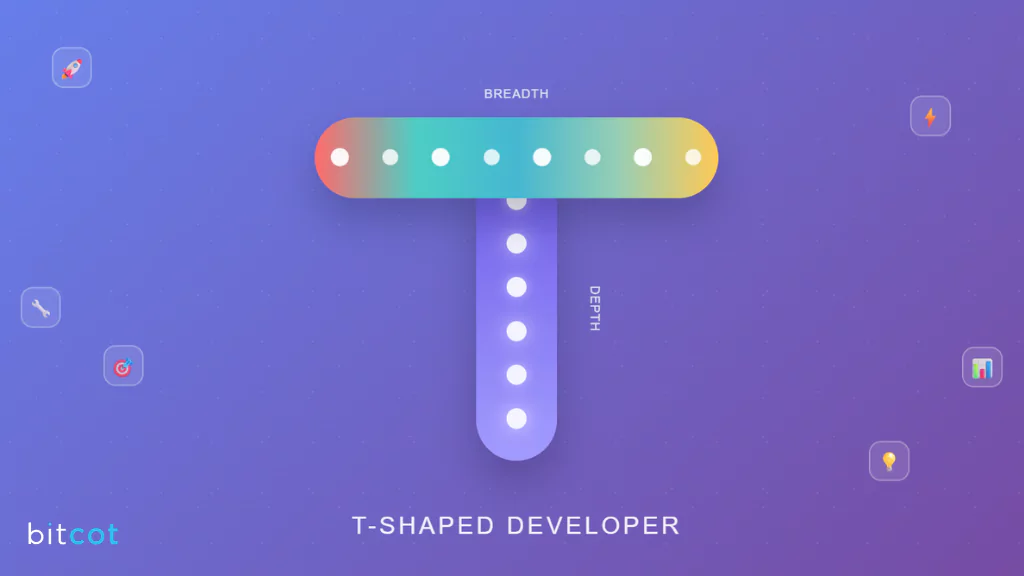
When it comes to building high-performing tech teams, not all developers are created equal.
A T-shaped developer is someone who brings a rare combination of depth and breadth to the table.
The concept is simple to visualize but powerful in practice: imagine the letter “T.”
The vertical line represents deep expertise in a specific area. This could be anything from front-end development, backend systems, or data engineering to mobile apps or DevOps. It’s the skill they truly excel at; the one area where they can confidently take ownership and deliver high-quality results with minimal supervision.
The horizontal line represents broad knowledge across other areas. This isn’t about being a master of everything; it’s about understanding how different parts of a project or system work together.
A T-shaped developer can collaborate with designers, product managers, QA engineers, and other specialists because they understand enough about each discipline to communicate effectively and contribute meaningfully.
Why should we care about this? Because modern software projects aren’t built in silos. A developer who only knows their specialty may struggle to see the bigger picture, leading to gaps, miscommunications, or slower project delivery. On the other hand, a T-shaped developer can bridge those gaps, anticipate challenges, and suggest solutions that benefit the whole team.
Real-world example: Imagine your company is launching a new web application. A deep front-end expert might excel at building a flawless UI, but if they don’t understand how the backend works, they could create components that are hard to integrate or maintain.
A T-shaped developer, while specializing in front-end work, understands backend constraints, can collaborate with backend developers, and might even suggest solutions that improve performance or scalability, saving time, cost, and headaches down the line.
In short, T-shaped developers aren’t just coders; they’re versatile problem-solvers who see the bigger picture, understand workflows across teams, and contribute in ways that multiply the value of your entire team.
For business leaders, hiring T-shaped talent isn’t just about filling a role; it’s about building a team that can innovate, adapt, and deliver consistently.
T-Shaped Developers vs. Full-Stack Developers: What’s the Difference?
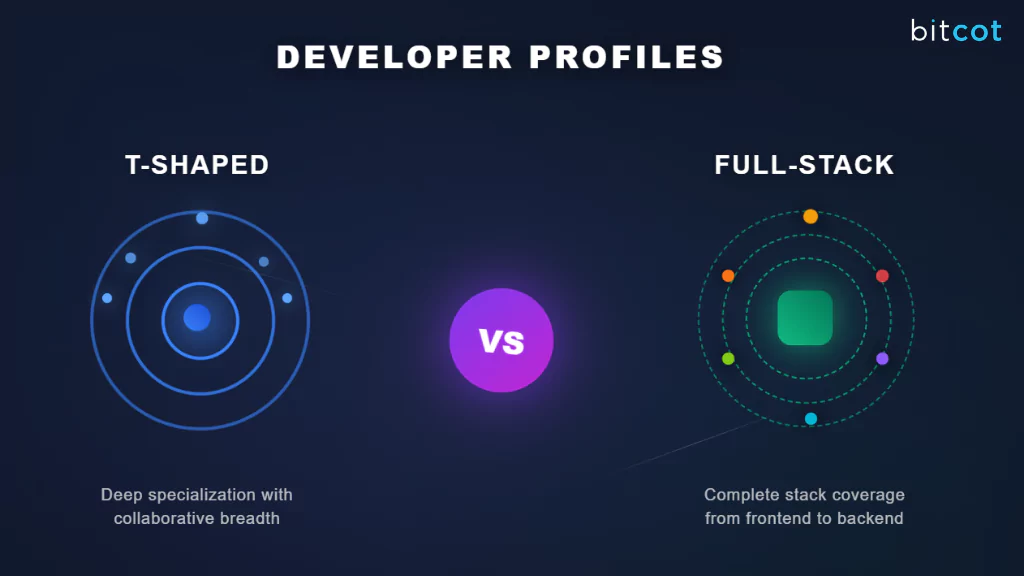
In today’s tech world, the terms T-shaped developer and full-stack developer often get mixed up.
At first glance, they may sound similar; they both bring versatility, adaptability, and the ability to work across different areas of development. But the truth is, they’re two very different types of talent, each with unique strengths.
For business leaders, knowing the distinction is key to hiring the right person for the right job.
1. Focus of Expertise
- Full-stack developers are known for working across the entire software stack. They’re comfortable writing frontend code, building backend logic, managing databases, and sometimes even dabbling in DevOps. Their depth is spread across multiple technologies rather than concentrated in a single domain.
- T-shaped developers, however, anchor themselves in one core area of deep expertise, say backend engineering, UX design, or data analysis. The horizontal part of the “T” comes from their ability to understand and collaborate with other disciplines. Their focus is not on mastering everything, but on applying curiosity and broad knowledge to work with specialists.
Example: Imagine building an e-commerce app. A full-stack developer might handle everything: coding the product pages, integrating the payment gateway, etc. A T-shaped backend developer, in contrast, would go deep into building a secure, scalable payment system but also understand how their work impacts frontend performance, user experience, and business objectives.
2. Collaboration and Adaptability
- Hiring full-stack developers is often most effective in lean teams or startups where “wearing many hats” is part of the job description. They bring speed and independence, since one person can take a feature from start to finish without much handoff.
- T-shaped developers thrive in larger, cross-functional teams where specialists need to work together. Their breadth allows them to communicate effectively with designers, QA testers, product managers, and other developers. They don’t just code; they connect, mediate, and bridge silos, making the whole team stronger.
Example: In a startup, a full-stack developer might be the perfect hire to quickly prototype a new app without needing multiple roles. In an enterprise software company, however, where you already have dedicated designers, QA, and infrastructure teams, a T-shaped developer will shine by ensuring smooth collaboration and alignment across disciplines.
3. Long-Term Value
- Full-stack developers deliver quick wins by being able to cover many roles at once. But because their skillset is broad, they may not achieve the same level of mastery in one area as a specialist. As technologies evolve, retraining across multiple layers of the stack can also be challenging.
- T-shaped developers bring resilience. Their depth in one domain means they can always add expert-level value, while their broad curiosity keeps them adaptable. When the business pivots or a new framework emerges, they learn quickly because they already think beyond their own silo.
Example: Say your company decides to shift from traditional web apps to mobile-first platforms. A full-stack web developer may need to spend months ramping up on mobile frameworks. A T-shaped frontend developer with strong UX knowledge, however, can adapt faster because they already understand user behavior, design principles, and how mobile performance impacts business results.
Why T-Shaped Developers Matter for Modern Businesses
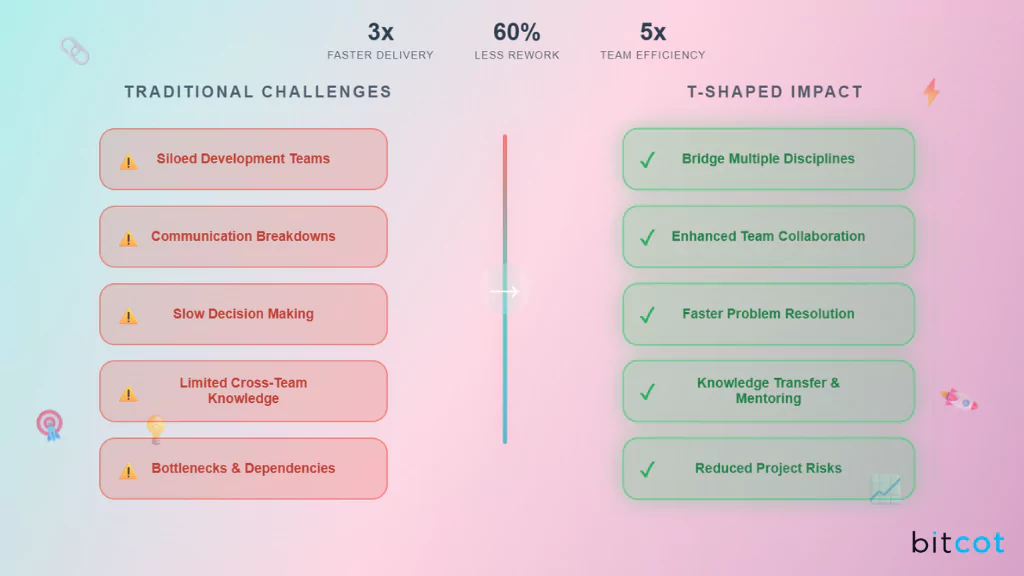
The way businesses build technology has transformed.
Projects no longer sit neatly in one lane; today’s products involve designers, backend engineers, frontend specialists, product managers, QA testers, marketers, and often even customers providing real-time feedback.
With so many moving parts, hiring developers who only understand their own narrow role creates bottlenecks, communication gaps, and costly delays.
That’s why T-shaped developers have become essential for modern businesses.
1. They bridge the gaps that slow teams down
In many organizations, departments operate like islands. Designers pass mockups to developers, who pass code to testers, and so on. Problems arise when those handoffs break down. A narrowly focused developer might say, “That’s not my job,” when something falls outside their expertise.
A T-shaped developer, however, knows enough about the other side to step in, ask the right questions, and keep the project moving.
Example: Imagine your company is building a new customer dashboard. A specialist front-end developer might focus solely on making the interface pixel-perfect, but if they don’t consider backend data limits, the design may crash under real-world usage.
A T-shaped developer, on the other hand, will anticipate these constraints, coordinate with backend colleagues, and suggest adjustments early, avoiding costly fixes later.
2. They make teams more agile
Change is the only constant in business. Deadlines shift, customer needs evolve, and unexpected technical hurdles appear.
With traditional “siloed” developers, teams often stall when something falls outside of one person’s specialty. T-shaped developers shine in these moments because their broad skill set lets them contribute in multiple ways. They might not replace a specialist, but they can provide enough support to keep progress flowing until the right expert steps in.
This agility is a game-changer for startups trying to move fast, or for established businesses modernizing legacy systems while keeping operations running.
3. They create more business value, not just technical output
At the end of the day, your company isn’t paying for lines of code; it’s paying for solutions that drive revenue, reduce costs, or improve customer satisfaction.
T-shaped developers are better at making these connections because they think beyond their immediate task. They understand how technical decisions ripple outward, impacting design, user experience, timelines, and even long-term maintenance costs.
Example: A backend-focused developer might optimize a database query for speed, but a T-shaped developer might also recognize how that improvement reduces server costs, shortens customer wait times, and enables new product features down the line. That’s business value in action.
4. They strengthen collaboration and culture
Culture isn’t just about Friday happy hours or team-building retreats; it’s about how people work together every day. In many teams, developers get so focused on their individual tasks that collaboration becomes transactional: “I finished my part, now it’s your turn.” That mindset can lead to finger-pointing when things go wrong and gaps when ownership isn’t clear.
T-shaped developers change that dynamic. Because they understand and appreciate the roles of designers, QA testers, product managers, and even business stakeholders, they naturally bridge divides. They’re quick to share knowledge, step in to help others, and encourage open dialogue across functions. Over time, this builds trust and a sense of collective ownership.
5. They future-proof your workforce
Hiring only narrow specialists can lock a business into today’s tools, leaving it vulnerable when technology shifts. And shift it will, whether it’s a new programming language, a framework rising in popularity, or an industry pivot toward AI or automation. Specialists often resist change because it pushes them outside their comfort zone. T-shaped developers, however, thrive in it.
Their breadth of knowledge allows them to quickly grasp new concepts and connect them to what they already know. They aren’t just learning tools; they’re learning how to learn. That makes them more adaptable when the business needs to pivot.
In a world where the only constant is change, T-shaped developers are like insurance for your workforce: they keep your team resilient, relevant, and ready for what’s next.
How to Identify T-Shaped Developers During the Hiring Process

Identifying T-shaped developers is about more than checking technical skills on a résumé.
These professionals combine deep expertise with cross-functional understanding and adaptability, making them valuable beyond their immediate role.
Business leaders need a structured approach that uncovers both their vertical and horizontal capabilities.
1. Assess depth in their specialty
The vertical line of a T-shaped developer represents their core expertise: the area where they can deliver high-quality results independently. During interviews, ask questions that reveal not just knowledge but applied problem-solving.
- “Can you walk me through the most challenging project in your specialty?”
- “What trade-offs did you make, and why?”
Example: A backend engineer might explain how they redesigned a database to handle high traffic while maintaining stability. They could describe trade-offs between performance and scalability, challenges with legacy systems, and how their solution impacted the project timeline. Candidates who provide these details demonstrate true mastery, not just familiarity with tools.
2. Evaluate breadth across disciplines
The horizontal line of a T-shaped developer shows their ability to collaborate across roles and understand broader workflows. Look for examples of cross-functional contributions:
- “Have you ever contributed outside your core role? How did you approach it?”
- “How do you ensure your work aligns with product, design, or business objectives?”
Example: A frontend developer may collaborate with backend engineers to optimize API calls or work with UX designers to improve user flow. Their ability to understand different perspectives and adapt their work accordingly signals the breadth needed for team-wide impact.
3. Observe communication and problem-solving skills
Breadth also shows in communication. T-shaped developers can explain technical concepts clearly to both technical and non-technical stakeholders, which is critical for cross-team alignment.
- Listen for clarity: Do they translate technical decisions into business impact?
- Watch for problem-solving: Do they weigh trade-offs for other teams or project goals?
Example: A data engineer implementing a new analytics pipeline could explain how improved processing speeds impact marketing reporting, product decisions, and customer experience. Candidates who communicate in this way show that they understand the bigger picture.
4. Test real-world scenarios and adaptability
Traditional coding tests only measure technical depth. To identify T-shaped developers, create exercises that simulate real project challenges requiring collaboration and adaptability:
- Present conflicting requirements from design and backend teams and ask how they would resolve it.
- Simulate a shift in priorities or an unexpected technical issue and observe their approach to problem-solving and communication.
Example: A developer might need to adjust backend workflows to accommodate a last-minute product change while coordinating with QA and design. The candidate’s ability to adapt, collaborate, and find a balanced solution reflects true T-shaped capabilities.
5. Check references for cross-functional impact
References can reveal how candidates operate in real team settings. Ask about their impact on team performance, not just individual contributions:
- Did they collaborate effectively with other teams?
- Did they step outside their specialty to solve problems?
- Did they elevate the team’s overall performance?
Example: A reference might share that the candidate proactively helped onboard new developers, suggested process improvements benefiting multiple departments, or assisted in solving critical cross-team challenges. This feedback confirms whether the candidate is genuinely T-shaped in practice.
How to Attract and Retain T-Shaped Developers
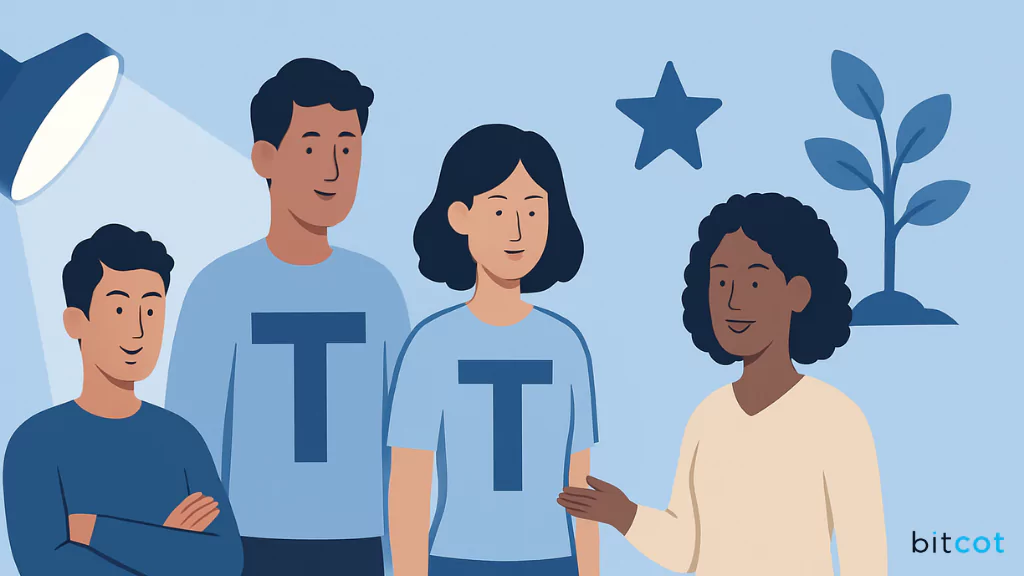
Identifying T-shaped developers is only half the battle.
Because they’re versatile and in high demand, keeping them engaged requires more than just a competitive salary. These professionals thrive in environments where they can deepen their expertise, expand their knowledge, and collaborate meaningfully.
Here’s how to attract and retain them.
1. Provide opportunities for growth beyond their specialty
T-shaped developers don’t want to be boxed into a narrow role. They’re most motivated when they can sharpen their core skills and stretch into new areas. Offer access to training programs, encourage side projects, and create opportunities for cross-team collaboration.
Example: A backend engineer might enjoy pairing with frontend developers to understand user interface performance or collaborating with DevOps to streamline deployment pipelines. These opportunities keep them engaged and growing.
2. Build a culture of collaboration
Because T-shaped developers thrive on teamwork, they’re drawn to environments where silos are broken down. Encourage open communication, cross-department workshops, and shared ownership of results. A collaborative culture not only attracts them but also allows them to maximize their strengths.
Example: Hosting regular “show and tell” sessions where developers, designers, and product managers demo their work creates transparency, sparks curiosity, and strengthens bonds across teams.
3. Offer meaningful challenges and autonomy
These professionals are problem-solvers by nature. If their role becomes repetitive or micromanaged, they’ll lose interest. To retain them, provide complex challenges, trust them with autonomy, and give them a voice in decision-making.
Example: Instead of simply assigning tasks, invite them into the planning process for a new product feature. Their input will not only improve the solution but also make them feel valued and trusted.
4. Recognize and reward cross-functional contributions
Many companies reward developers only for technical achievements, overlooking the value of collaboration. T-shaped developers should be recognized for mentoring others, improving workflows, or bridging gaps between teams. Public acknowledgment of these contributions encourages them to keep sharing their strengths.
Example: Celebrate a developer who helped QA automate tests or who worked with design to refine user flows. Recognition in performance reviews or team meetings reinforces the importance of breadth, not just depth.
5. Create a long-term vision they can connect with
T-shaped developers are naturally curious and forward-looking. To retain them, align their growth with the company’s long-term vision. Share where the business is heading, how technology fits into that future, and the role they can play in shaping it.
Example: If your company is expanding into AI-driven products, involve developers in early research or pilot projects. This positions them as partners in innovation, not just executors of tasks.
Partner with Bitcot to Future-Proof Your Workforce with T-Shaped Talent
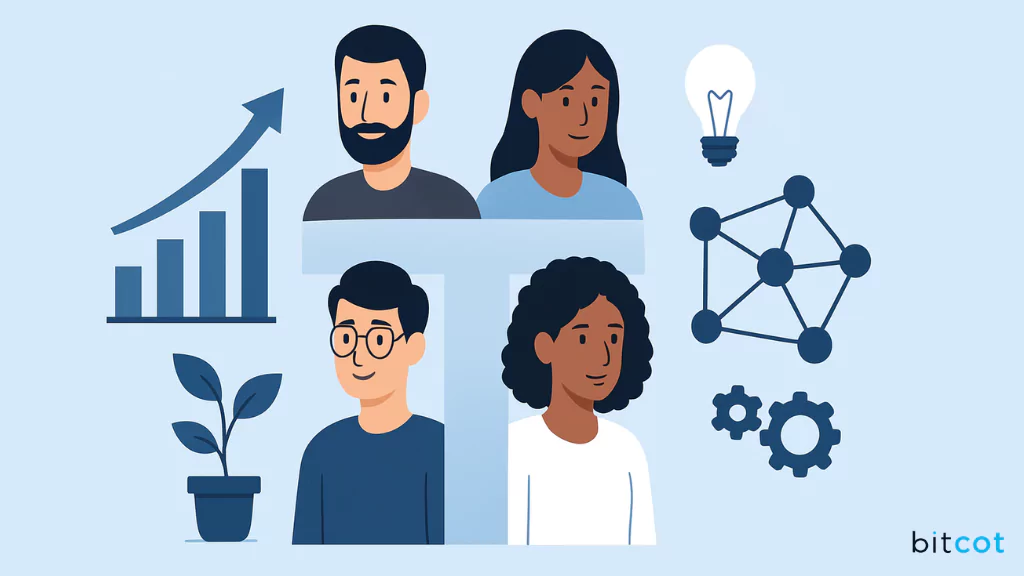
The pace of technological change has never been faster. Frameworks rise and fall, customer expectations evolve overnight, and businesses that can’t adapt risk being left behind.
That’s why hiring T-shaped developers isn’t just a smart move; it’s a future-proofing strategy. These professionals combine deep expertise in one discipline with the versatility to collaborate across others, making them resilient no matter how the tech landscape shifts.
But here’s the challenge: T-shaped talent is rare, and competition for them is fierce. Many companies spend months searching, only to end up with narrowly focused specialists who struggle to keep up with change.
This is where Bitcot can help.
At Bitcot, we’ve built our reputation on assembling teams of high-performing T-shaped developers who are as strong in collaboration as they are in coding. Our developers don’t just ship features; they align with your business goals, adapt to your evolving tech stack, and elevate the performance of everyone around them.
When you partner with Bitcot, you’re not just hiring developers; you’re building a resilient workforce designed for the future.
Here’s what that means for you:
- Adaptive Expertise: Developers who go deep where it matters, but also pivot quickly when new technologies emerge.
- Cross-functional Collaboration: Talent that breaks down silos and strengthens communication across design, product, QA, and leadership.
- Continuous Innovation: Curious, forward-looking professionals who bring fresh ideas and keep your projects ahead of the curve.
- Proven Scalability: From startups to enterprises, our teams flex with your needs while maintaining quality and speed.
If you want to hire a full-stack dev team that can thrive today and adapt to tomorrow, Bitcot is your trusted partner for sourcing and growing T-shaped talent. Together, we’ll ensure your workforce is not just ready for the future, but ahead of it.
Final Thoughts

Hiring the right talent is no longer just about technical skills; it’s about adaptability, collaboration, and long-term impact. T-shaped developers bring exactly that to the table.
With deep expertise in one area and a broad understanding of other disciplines, they help teams innovate faster, communicate better, and stay resilient in the face of change.
For business leaders, leveraging T-shaped talent means investing in professionals who not only solve complex problems but also elevate everyone around them. Compared to full-stack developers, T-shaped developers offer a unique balance of depth and breadth, making them ideal for projects that require both technical mastery and cross-functional collaboration.
To build a team that can keep up with today’s evolving technology and deliver sustainable results, partnering with the right experts is crucial.
As a leading app development agency, Bitcot connects businesses with top-tier T-shaped developers who drive innovation, strengthen team culture, and future-proof your workforce.
Get started with Bitcot today and transform your team into a collaborative, high-performing unit ready for the challenges of tomorrow.












